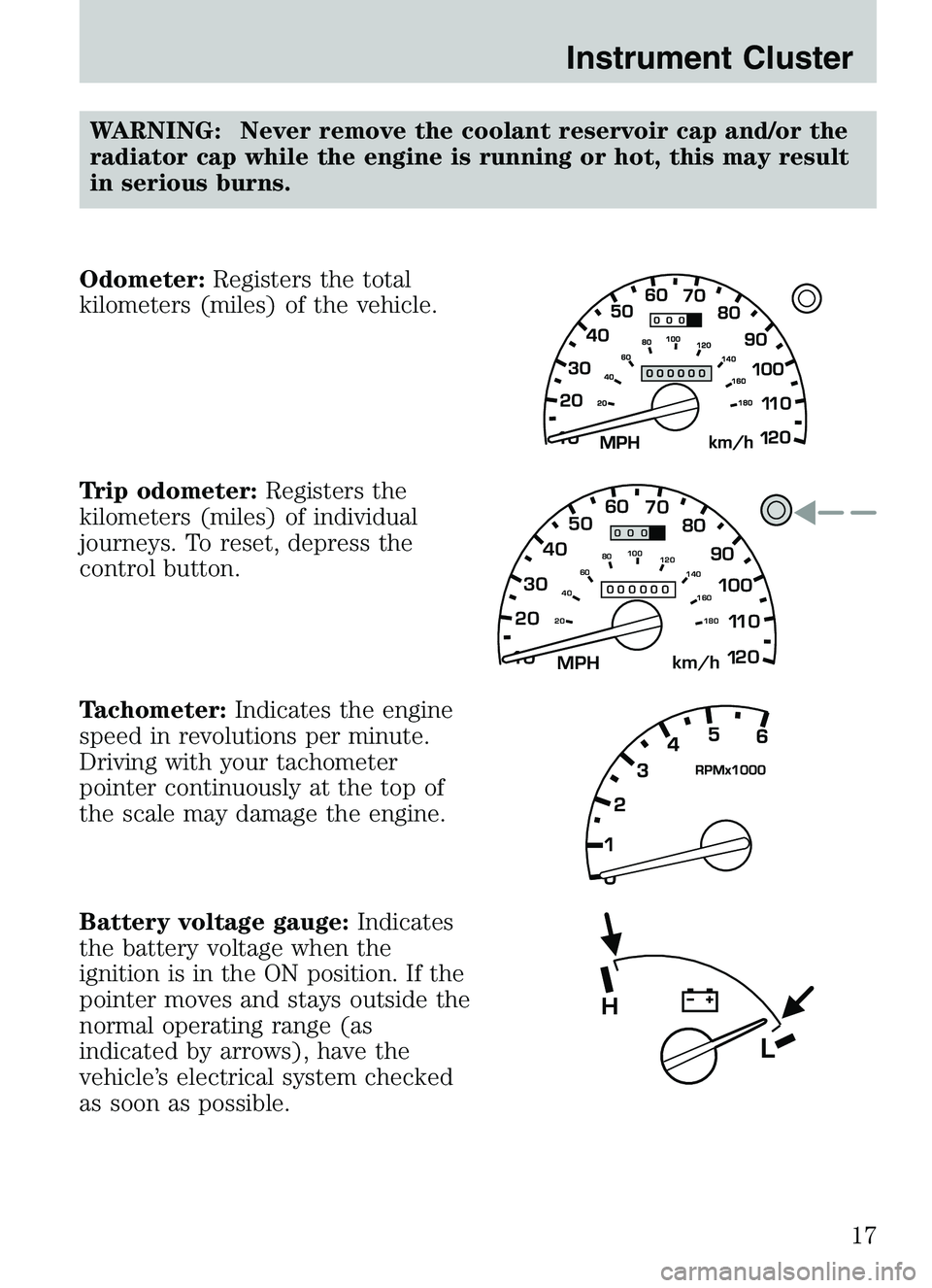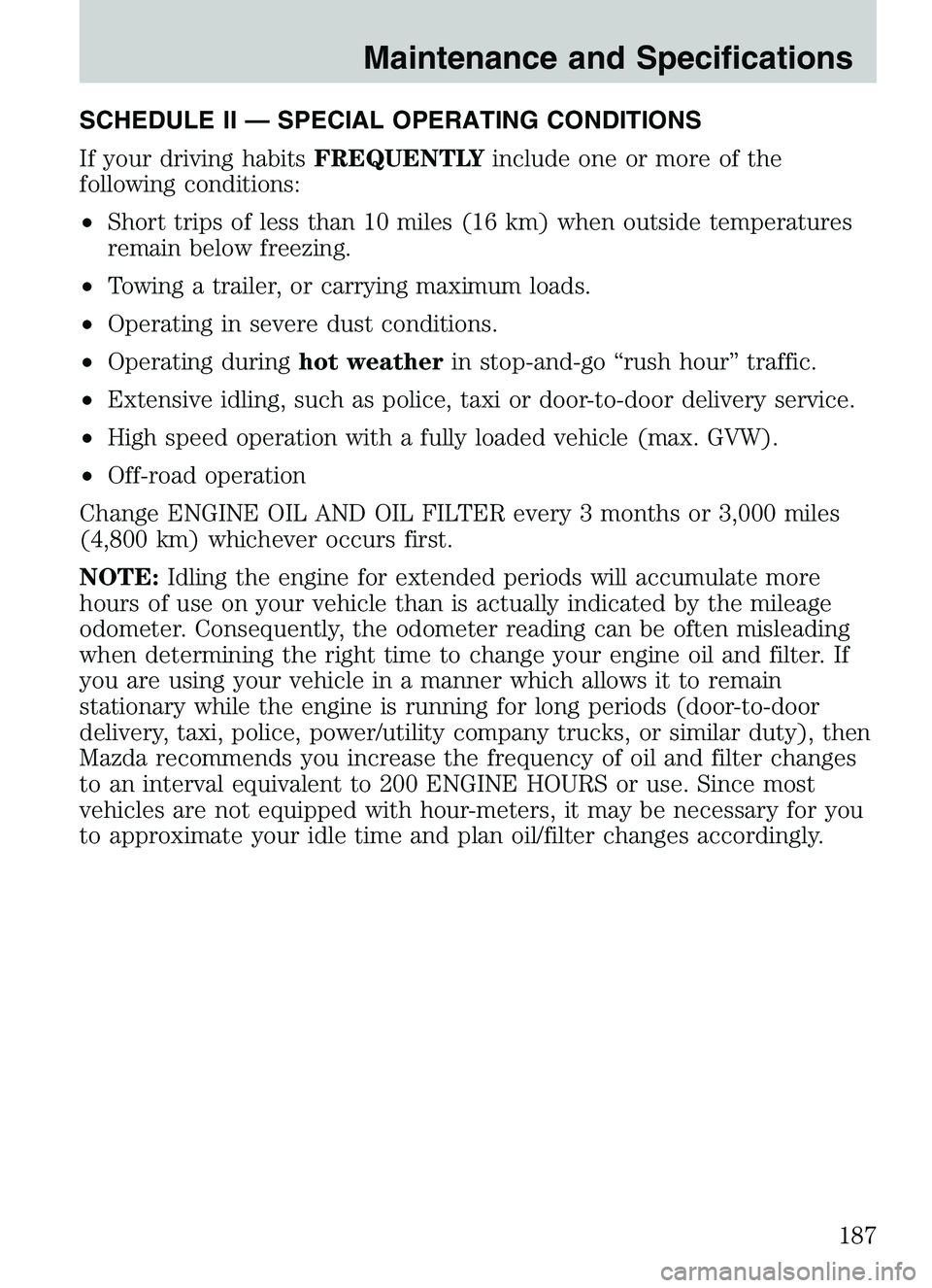odometer MAZDA MODEL B4000 2003 Owners Manual
[x] Cancel search | Manufacturer: MAZDA, Model Year: 2003, Model line: MODEL B4000, Model: MAZDA MODEL B4000 2003Pages: 250, PDF Size: 2.85 MB
Page 17 of 250

WARNING: Never remove the coolant reservoir cap and/or the
radiator cap while the engine is running or hot, this may result
in serious burns.
Odometer: Registers the total
kilometers (miles) of the vehicle.
Trip odometer: Registers the
kilometers (miles) of individual
journeys. To reset, depress the
control button.
Tachometer: Indicates the engine
speed in revolutions per minute.
Driving with your tachometer
pointer continuously at the top of
the scale may damage the engine.
Battery voltage gauge: Indicates
the battery voltage when the
ignition is in the ON position. If the
pointer moves and stays outside the
normal operating range (as
indicated by arrows), have the
vehicle’s electrical system checked
as soon as possible.
10MPH
20 50
60
70
30 40
80
90
km/h
0 0 0
101
00
1
20
1
0 0 0 0 0 040 60
80
100
120
140
160180
20
L
H
Instrument Cluster
17
Page 166 of 250

CUSTOMER ASSISTANCE (CANADA)
Your complete and permanent satisfaction is our business. We are here to
serve you. All Authorized Mazda Dealers have the knowledge and the
tools to keep your Mazda vehicle in top condition.
In our experience, any questions, problems or complaints regarding the
operation of your Mazda or any other general service transactions are
most effectively resolved by your dealer. If the cause of your
dissatifaction cannot adequately be addressed by normal dealership
procedures, we recommend that you take the following steps:
STEP 1: Contact Your Mazda Dealer
Discuss the matter with a member of dealership management. If the
Service Manager has already reviewed your concerns, contact the owner
of the dealership or its General Manager
STEP 2: Call the Mazda Regional Office
If you feel that you still require assistance, ask the dealer Service
Manager to arrange for you to meet the local Mazda Service
Representative. If more expedient, contact Mazda Canada Inc. Regional
Office nearest you for such arrangements.
STEP 3: Contact the Mazda Customer Relations Department
If still not substantially satisfied, contact the Customer Relations
Department, Mazda Canada Inc., 305 Milner Avenue, Suite 400
Scarborough, Ontario M1B 3V4 Canada TEL: 1 (800) 263–4680.
Provide the Department with the following information:1. Your name, address, and telephone number
2. Year and model of vehicle
3. Vehicle Identification Number (VIN). Refer to the “Vehicle Identification Labels” page of section 10 of this manual for the
location of the VIN.
4. Purchase date.
5. Present odometer reading.
6. Your dealer’s name and location
7. The nature of your problem and/or cause of dissatisfaction.
The Department, in cooperation with the local Mazda Service
Representative, will review the case to determine if everything possible
has been done to ensure your satisfaction.
Please recognize that the resolution of service problems in most cases
requires the use of your Mazda dealer’s service facilities. personnel and
Customer Assistance
166
Page 187 of 250

SCHEDULE II — SPECIAL OPERATING CONDITIONS
If your driving habitsFREQUENTLYinclude one or more of the
following conditions:
• Short trips of less than 10 miles (16 km) when outside temperatures
remain below freezing.
• Towing a trailer, or carrying maximum loads.
• Operating in severe dust conditions.
• Operating during hot weatherin stop-and-go “rush hour” traffic.
• Extensive idling, such as police, taxi or door-to-door delivery service.
• High speed operation with a fully loaded vehicle (max. GVW).
• Off-road operation
Change ENGINE OIL AND OIL FILTER every 3 months or 3,000 miles
(4,800 km) whichever occurs first.
NOTE: Idling the engine for extended periods will accumulate more
hours of use on your vehicle than is actually indicated by the mileage
odometer. Consequently, the odometer reading can be often misleading
when determining the right time to change your engine oil and filter. If
you are using your vehicle in a manner which allows it to remain
stationary while the engine is running for long periods (door-to-door
delivery, taxi, police, power/utility company trucks, or similar duty), then
Mazda recommends you increase the frequency of oil and filter changes
to an interval equivalent to 200 ENGINE HOURS or use. Since most
vehicles are not equipped with hour-meters, it may be necessary for you
to approximate your idle time and plan oil/filter changes accordingly.
Maintenance and Specifications
187
Page 216 of 250

•Have the vehicle loading and distribution the same every time.
Your results will be most accurate if your filling method is consistent.
Calculating fuel economy 1. Fill the fuel tank completely and record the initial odometer reading (in kilometers or miles).
2. Each time you fill the tank, record the amount of fuel added (in liters or gallons).
3. After at least three to five tank fill-ups, fill the fuel tank and record the current odometer reading.
4. Subtract your initial odometer reading from the current odometer reading.
5. Follow one of the simple calculations in order to determine fuel economy:
Calculation 1: Multiply liters used by 100, then divide by total
kilometers traveled.
Calculation 2: Divide total miles traveled by total gallons used.
Keep a record for at least one month and record the type of driving (city
or highway). This will provide an accurate estimate of the vehicle’s fuel
economy under current driving conditions. Additionally, keeping records
during summer and winter will show how temperature impacts fuel
economy. In general, lower temperatures give lower fuel economy.
Driving style — good driving and fuel economy habits
Give consideration to the lists that follow and you may be able to change
a number of variables and improve your fuel economy.
Habits
• Smooth, moderate operation can yield up to 10% savings in fuel.
• Steady speeds without stopping will usually give the best fuel
economy.
• Idling for long periods of time (greater than one minute) may waste
fuel.
• Anticipate stopping; slowing down may eliminate the need to stop.
• Sudden or hard accelerations may reduce fuel economy.
• Slow down gradually.
• Driving at reasonable speeds (traveling at 88 km/h [55 mph] uses 15%
less fuel than traveling at 105 km/h [65 mph]).
2003 Mazda B Series (mbs)
New Owners Guide own2002 (own2002)
USA English (fus)
Maintenance and Specifications
216